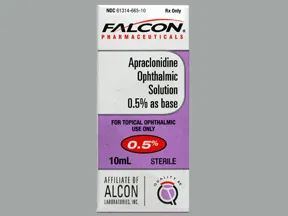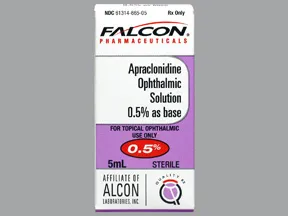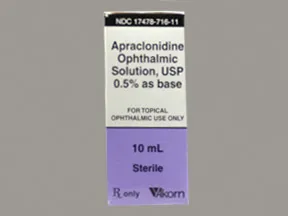Uses
Apraclonidine is used along with other medications to treat serious high pressure inside the eye (glaucoma) for a short time (such as 1 month) to help delay or prevent the need for eye surgery. Decreasing high pressure inside the eye may help to prevent decreased vision or blindness. Apraclonidine is thought to work by decreasing the amount of fluid within the eye.
How to use apraclonidine ophthalmic (eye)
Use this medication in the affected eye(s) as directed by your doctor, usually 3 times daily.
If you are wearing contact lenses, remove them before using eye drops. Wait at least 15 minutes before replacing your contact lenses.
To apply eye drops, wash your hands first. To avoid contamination, be careful not to touch the dropper tip or let it touch your eye or any other surface.
Tilt your head back, look up, and pull down the lower eyelid to make a pouch. Hold the dropper directly over your eye and place 1 drop into the pouch. Release the eyelid and gently close your eyes. Place one finger at the corner of your eye (near the nose) and apply gentle pressure for 1 to 2 minutes. This will prevent the medication from draining out. Try not to blink and do not rub your eye. Repeat these steps for your other eye if so directed or if your dose is for more than 1 drop.
Remove extra solution around the eye with a tissue and wash your hands to remove any medicine that may be on them.
If you are using another kind of eye medication (such as drops or ointments), wait at least 5 minutes before using the other medication. Use eye drops before ointments to allow the eye drops to enter the eye.
Wait several minutes for your vision to clear before driving or operating machinery.
Dosage is based on your medical condition and response to treatment. Do not increase your dose or use it more often than prescribed. When used for an extended time, this medication may not work as well and may require different dosing. Your doctor will monitor your progress with regular eye exams.
Side Effects
Eye discomfort/redness/burning, blurred vision, dry mouth/nose, dizziness, drowsiness, upset stomach, or unusual tiredness may occur. Eye itching/watering or eyelid swelling may be symptoms of an allergic reaction of the eye. If any of these effects last or get worse, tell your doctor or pharmacist promptly.
Remember that this medication has been prescribed because your doctor has judged that the benefit to you is greater than the risk of side effects. Many people using this medication do not have serious side effects.
Tell your doctor right away if you have any serious side effects, including: mental/mood changes (such as depression, irritability), slow/irregular heartbeat.
A very serious allergic reaction to this drug is rare. However, get medical help right away if you notice any symptoms of a serious allergic reaction, including: rash, itching/swelling (especially of the face/tongue/throat), severe dizziness, trouble breathing.
This is not a complete list of possible side effects. If you notice other effects not listed above, contact your doctor or pharmacist.
In the US -
Call your doctor for medical advice about side effects. You may report side effects to FDA at 1-800-FDA-1088 or at www.fda.gov/medwatch.
In Canada - Call your doctor for medical advice about side effects. You may report side effects to Health Canada at 1-866-234-2345.
Precautions
Before using apraclonidine, tell your doctor or pharmacist if you are allergic to it; or to clonidine; or if you have any other allergies. This product may contain inactive ingredients, which can cause allergic reactions or other problems. Talk to your pharmacist for more details.
Before using this medication, tell your doctor or pharmacist your medical history, especially of: blood vessel disease (such as cerebrovascular disease, Raynaud's disease), high blood pressure, heart problems (such as recent heart attack), kidney disease, mental/mood disorders (such as depression).
After you apply this drug, your vision may become temporarily blurred or unstable. This drug may also rarely make you dizzy or drowsy. Alcohol or marijuana (cannabis) can make you more dizzy or drowsy. Do not drive, use machinery, or do anything that needs alertness or clear vision until you can do it safely. Limit alcoholic beverages. Talk to your doctor if you are using marijuana (cannabis).
During pregnancy, this medication should be used only when clearly needed. Discuss the risks and benefits with your doctor.
It is unknown if this medication passes into breast milk. Consult your doctor before breastfeeding.
Interactions
Drug interactions may change how your medications work or increase your risk for serious side effects. This document does not contain all possible drug interactions. Keep a list of all the products you use (including prescription/nonprescription drugs and herbal products) and share it with your doctor and pharmacist. Do not start, stop, or change the dosage of any medicines without your doctor's approval.
Taking MAO inhibitors with this medication may cause a serious (possibly fatal) drug interaction. Avoid taking MAO inhibitors (isocarboxazid, linezolid, metaxalone, methylene blue, moclobemide, phenelzine, procarbazine, rasagiline, safinamide, selegiline, tranylcypromine) during treatment with this medication. Most MAO inhibitors should also not be taken for two weeks before treatment with this medication. Ask your doctor when to start or stop taking this medication.
Tell your doctor or pharmacist if you are taking other products that cause drowsiness including alcohol, marijuana (cannabis), antihistamines (such as cetirizine, diphenhydramine), drugs for sleep or anxiety (such as alprazolam, diazepam, zolpidem), muscle relaxants, and opioid pain relievers (such as codeine).
Check the labels on all your medicines (such as cough-and-cold products) because they may contain ingredients that may cause drowsiness. Ask your pharmacist about using those products safely.
Overdose
This medicine may be harmful if swallowed. If someone has overdosed and has serious symptoms such as passing out or trouble breathing, call 911. Otherwise, call a poison control center right away. US residents can call 1-800-222-1222. Canada residents can call 1-844-764-7669. Symptoms of overdose may include: slow heartbeat, drowsiness, cold/clammy skin.
Do not share this medication with others.
Lab and/or medical tests (such as pulse, blood pressure, eye exams) may be done while you are using this medication. Keep all medical and lab appointments. Consult your doctor for more details.
If you miss a dose, use it as soon as you remember. If it is near the time of the next dose, skip the missed dose. Use your next dose at the regular time. Do not double the dose to catch up.
Store in the refrigerator or at room temperature away from light. Do not freeze. Keep all medications away from children and pets.
Do not flush medications down the toilet or pour them into a drain unless instructed to do so. Properly discard this product when it is expired or no longer needed. Consult your pharmacist or local waste disposal company.
Images

apraclonidine 0.5 % eye drops
Color: clearShape: Imprint:This medicine is a clear, clear, drops

apraclonidine 0.5 % eye drops
Color: clearShape: Imprint:This medicine is a clear, clear, drops

apraclonidine 0.5 % eye drops
Color: colorlessShape: Imprint:This medicine is a clear, clear, drops

apraclonidine 0.5 % eye drops
Color: colorlessShape: Imprint:This medicine is a clear, clear, drops
Are you currently using apraclonidine ophthalmic (eye)?
This survey is being conducted by the WebMD marketing sciences department.
Selected from data included with permission and copyrighted by First Databank, Inc. This copyrighted material has been downloaded from a licensed data provider and is not for distribution, except as may be authorized by the applicable terms of use.
CONDITIONS OF USE: The information in this database is intended to supplement, not substitute for, the expertise and judgment of healthcare professionals. The information is not intended to cover all possible uses, directions, precautions, drug interactions or adverse effects, nor should it be construed to indicate that use of a particular drug is safe, appropriate or effective for you or anyone else. A healthcare professional should be consulted before taking any drug, changing any diet or commencing or discontinuing any course of treatment.